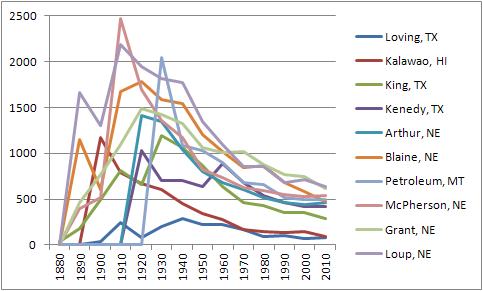There are places so obscure that they achieve a level of notoriety in geo-oddity circles. Examples would include Loving County, Texas and Kalawao County, Hawaii, which are both revered in the county counting community. No county has fewer residents than Loving with only 82 people recorded in the 2010 Decennial Census.
Kalawao comes in a close second with 90 residents. However, its claim-to-fame isn’t associated with population but with size — it’s the smallest county in the United States at only 13.2 square miles of land. Both locations have been discussed on the Twelve Mile Circle (in “Is Everything Really Bigger in Texas?” and in Smallest County in the USA, Part 1) and on many other geo-blogs ad infinitum.
Odd geography enthusiasts go out of their way to visit Loving and Kalawao. Even the mainstream Press lauds attention on them with a regular streams of human interest stories. I guess reporters need to find something to do between news cycles. They’ll trudge down to the Loving County’s seat at Mentone (population 19) and interview whoever decided to be sheriff that year like they’re the first ones that ever thought of it.
Beyond the Spotlight
Nobody every pays attention to the less fortunate counties that come after Loving and Kalawao, the remaining eight that round-out the Top 10 of the least populated. So let’s give a little nod to those tiny places that aren’t quite obscure enough to occupy the limelight. Here is the Top (bottom?) 10 as tallied by the U.S. Census Bureau in 2010:
- Loving, TX (82)
- Kalawao, HI (90)
- King, TX (286)
- Kenedy, TX (416) – easternmost county in the US with less than one person per square mile
- Arthur, NE (460)
- Blaine, NE (478)
- Petroleum, MT (494) – newest county in Montana (est. 1926)
- McPherson, NE (539)
- Grant, NE (614)
- Loup, NE (632)
Nebraska
It’s striking that Nebraska contains fully half of the least populous counties in the Top 10, albeit Texas also has a lock on several top spots. Clearly Nebraska has an opportunity to capitalizing on its unique situation.
We’ve seen plenty of travel corridors created to promote tourism: wine and beer trails; exploration routes; and nostalgic motor roads to name a few. I propose the Nebraska Overlooked County Trail. Maybe visitors will get a little prize when they collect a stamp at each county courthouse or something. It wouldn’t take a lot of tourism to create positive impacts in locations this small, so take a drive and hit a cluster of the absolutely most obscure of obscure counties.
Amazingly, this entire course can be completed in less than 4 hours while covering barely 200 miles (335 km).

Highlights would include the original Arthur County courthouse (now the Arthur County Historical Society Museum) alleged to be the smallest courthouse in the United States up until around 1960. I’m having trouble finding any other highlights besides the scenery but I’m sure they exist! We just have to think a little more creatively. I offer all rights to this idea to the Nebraska Division of Travel and Tourism to develop and publicize as they wish.
Changes Over Time

Strange things may be afoot in the future. Kalawao could eclipse Loving. The unusual situation of Kalawao continues to drain its population. In 2010, only 2% of the people living there were under age 18 and its median age was 59. Meanwhile, Loving has been holding steady for the last thirty years and even gained population in 2010. Eventually Kalawao will disappear as a county unable to replenish its population. However it’s not inconceivable that it will shove Loving aside before that happens.
I am guessing that will occur in the 2020 Decennial Census, and it will attract appreciable media attention when it captures both the diminutive size and population honors. Tourism interest will increase and it will become increasingly difficult to secure permission to visit. See Kalawao before 2020 if you want include it on your list of counties counted.
Most of the counties peaked their population in the early 20th Century before declining slowly before bottoming out in the last couple of decades. It will be interesting to see whether any of these counties rebound as white-collar jobs become increasingly free of geography and children no longer need to move away as they become adults.

Leave a Reply